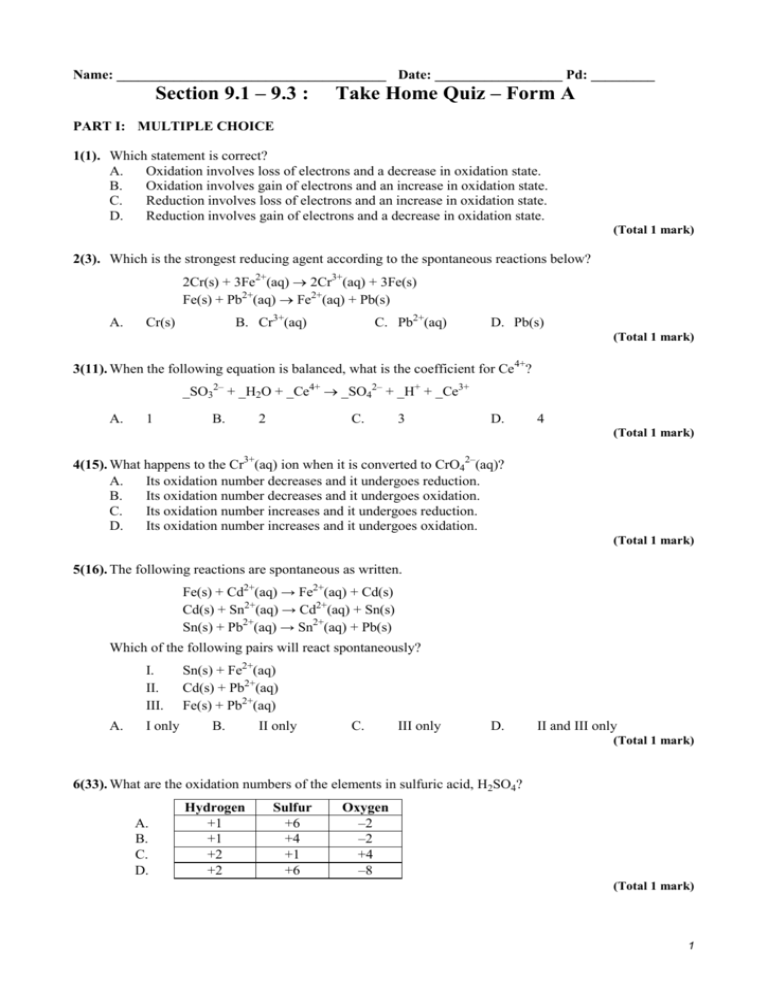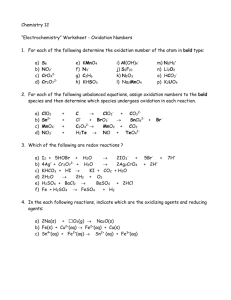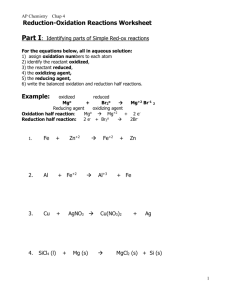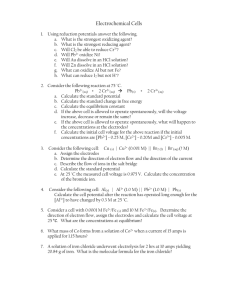Section 9.1 – 9.3 : Take Home Quiz – Form A – ANSWER KEY
advertisement

Name: ______________________________________ Date: __________________ Pd: _________ Section 9.1 – 9.3 : Take Home Quiz – Form A PART I: MULTIPLE CHOICE 1(1). Which statement is correct? A. Oxidation involves loss of electrons and a decrease in oxidation state. B. Oxidation involves gain of electrons and an increase in oxidation state. C. Reduction involves loss of electrons and an increase in oxidation state. D. Reduction involves gain of electrons and a decrease in oxidation state. (Total 1 mark) 2(3). Which is the strongest reducing agent according to the spontaneous reactions below? 2Cr(s) + 3Fe2+(aq) 2Cr3+(aq) + 3Fe(s) Fe(s) + Pb2+(aq) Fe2+(aq) + Pb(s) A. B. Cr3+(aq) Cr(s) C. Pb2+(aq) D. Pb(s) (Total 1 mark) 3(11). When the following equation is balanced, what is the coefficient for Ce4+? _SO32– + _H2O + _Ce4+ _SO42– + _H+ + _Ce3+ A. 1 B. 2 C. 3 D. 4 (Total 1 mark) 4(15). What happens to the Cr3+(aq) ion when it is converted to CrO42–(aq)? A. Its oxidation number decreases and it undergoes reduction. B. Its oxidation number decreases and it undergoes oxidation. C. Its oxidation number increases and it undergoes reduction. D. Its oxidation number increases and it undergoes oxidation. (Total 1 mark) 5(16). The following reactions are spontaneous as written. Fe(s) + Cd2+(aq) → Fe2+(aq) + Cd(s) Cd(s) + Sn2+(aq) → Cd2+(aq) + Sn(s) Sn(s) + Pb2+(aq) → Sn2+(aq) + Pb(s) Which of the following pairs will react spontaneously? I. II. III. A. I only Sn(s) + Fe2+(aq) Cd(s) + Pb2+(aq) Fe(s) + Pb2+(aq) B. II only C. III only D. II and III only (Total 1 mark) 6(33). What are the oxidation numbers of the elements in sulfuric acid, H2SO4? A. B. C. D. Hydrogen +1 +1 +2 +2 Sulfur +6 +4 +1 +6 Oxygen –2 –2 +4 –8 (Total 1 mark) 1 7(36). The unbalanced equation for the conversion of sulfur dioxide to sulfuric acid is given below. ___SO2 + ___H2O → ___ H2SO4 Which other species are used, and on which side of the equation, to balance it? A. H+ and e– on the left C. H+ on the right and e– on the left + – B. H on the left and e on the right D. H+ and e– on the right (Total 1 mark) 8(40). Which equation represents a redox reaction? A. KOH(aq) + HCl(aq) KCl(aq) + H2O(l) B. Mg(s) + 2HCl(aq) MgCl2(aq) + H2(g) C. CuO(s) + 2HCl(aq) CuCl2(aq) + H2O(l) D. ZnCO3(s) + 2HCl(aq) ZnCl2(aq) + CO2(g) + H2O(l) (Total 1 mark) 9(57). Which are examples of reduction? I. II. III. A. B. Fe3+ becomes Fe2+ Cl– becomes Cl2 CrO3 becomes Cr3+ I and II only I and III only C. D. II and III only I, II and III (Total 1 mark) 10(65). In which change does nitrogen undergo oxidation? A. B. C. D. NO2 N2O4 NO3– NO2 N2O5 NO3– NH3 N2 (Total 1 mark) 11(75). Which statement is correct about an oxidizing agent in a chemical reaction? A. It reacts with oxygen. C. It loses electrons. + B. It reacts with H ions. D. It undergoes reduction. (Total 1 mark) 12(81). What is the reducing agent in this reaction? Cu(s) + 2 NO 3 (aq) + 4H+(aq) → Cu2+(aq) + 2NO2(g) + 2H2O(l) A. Cu(s) B. NO 3 (aq) C. Cu2+(aq) D. H+(aq) (Total 1 mark) 2 PART II: OPEN RESPONSE 12(19). A part of the reactivity series of metals, in order of decreasing reactivity, is shown below. magnesium zinc iron lead copper silver If a piece of copper metal were placed in separate solutions of silver nitrate and zinc nitrate (i) determine which solution would undergo reaction. …………………………………………………………………………………………… (ii) identify the type of chemical change taking place in the copper and write the half-equation for this change. …………………………………………………………………………………………… …………………………………………………………………………………………… (iii) state, giving a reason, what visible change would take place in the solutions. …………………………………………………………………………………………… …………………………………………………………………………………………… …………………………………………………………………………………………… …………………………………………………………………………………………… (1) (2) (2) (Total 5 marks) 13(51). In terms of electron transfer define: (i) oxidation .................................................................................................................................... .................................................................................................................................... (1) (ii) oxidizing agent .................................................................................................................................... .................................................................................................................................... (1) (Total 2 marks) 14(72). Tin(II) ions can be oxidized to tin(IV) ions by acidified potassium permanganate(VII) solution according to the following unbalanced equation. __ Sn2+ + __MnO4– + __ H+ __ Sn4+ + __Mn2+ + __ H2O (a) Identify the oxidizing agent and the reducing agent. Oxidizing agent ......................................................................................................... Reducing agent .......................................................................................................... (1) (b) Balance the equation above. .................................................................................................................................... .................................................................................................................................... (1) (Total 2 marks) 3 Section 9.1 – 9.3 : Take Home Quiz – Form A – ANSWER KEY PART I: MULTIPLE CHOICE 1(1). D [1] 2(3). A [1] 3(11). B 4(15). D 5(16). D 6(33). A 7(36). D 8(40). B 9(57). B 10(65). D 11(75). D 12(81). A [1] [1] PART II: OPEN RESPONSE 12(19). (ii) (iii) 19. (i)silver nitrate; oxidation; Cu → Cu2+ + 2e; 2 (silver nitrate) solution turns blue/grey or black or silver solid forms; copper ions form/Cu2+ ions form/silver deposited; 2 [5] 13(51). (i) (ii) loss of electrons; 1 (a species that) gains electrons (from another species)/causes electron loss; 1 [2] 14(72). (a) oxidizing agent: (acidified) potassium permanganate(VII)/(H+) and Mn O 4 (b) and reducing agent: Sn2+; Both oxidizing agent and reducing agent required for [1]. 1 5Sn2+ + 2MnO4– + 16H+ 5Sn4+ + 2Mn2+ + 8H2O; 1 4









